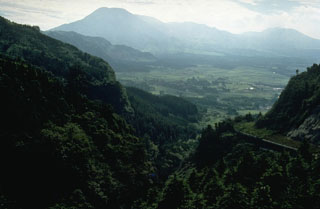Report on Asosan (Japan) — November 1997
Bulletin of the Global Volcanism Network, vol. 22, no. 11 (November 1997)
Managing Editor: Richard Wunderman.
Asosan (Japan) Two tourists killed by volcanic gas on 23 November
Please cite this report as:
Global Volcanism Program, 1997. Report on Asosan (Japan) (Wunderman, R., ed.). Bulletin of the Global Volcanism Network, 22:11. Smithsonian Institution. https://doi.org/10.5479/si.GVP.BGVN199711-282110
Asosan
Japan
32.8849°N, 131.085°E; summit elev. 1592 m
All times are local (unless otherwise noted)
Tomoki Tsutsui (Aso Volcanological Laboratory, Kyoto University) reported that a new fumarolic vent ~10 m in diameter formed on the S wall of Crater 1 in early November; later, small mounds of mud formed around the vent. Although Crater 1 had been quiet since 1993, hot greenish-gray water remained in the crater. Videos of Crater 1 taken by the Aso Volcano Museum recorded emissions of mud fragments and white fumes from the new vent, as well as a bubbling noise; other instruments detected low-level volcanic tremors.
According to news reports, inhalation of volcanic gas killed two men, aged 62 and 51 years, after they collapsed ~100 m S of Crater 1's rim at 0945 and 1040 on 23 November. Volcanic gas concentration around the crater is monitored using a sensor installed by the Japan Meteorological Agency in April 1997. Due to high levels of SO2 (~5 ppm), the Crater 1 overlook was closed on the morning of 23 November, but re-opened at 0900 when the SO2 level dropped to2 levels rose to ~8 ppm. The weather station at Aso had recorded no abnormal volcanic conditions.
Seventy-one people have been hospitalized due to inhalation of volcanic gases at Aso since 1980; of those, seven were killed. In June 1994, five junior high school students on a field trip collapsed near Crater 1.
Aso, a 24-km wide caldera, produced Pleistocene pyroclastic-flow deposits that cover much of Kyushu. Fifteen central cones form an E-W line on the caldera floor. Naka-dake, one of the intra-caldera cones, has erupted more than 165 times since 553 AD. Naka-dake has a group of craters (1.1 km long) including Crater 1 at the summit. Strombolian, phreatic, and phreatomagmatic eruptions are common in Crater 1. The 4 km2 100-m-deep Crater 1 is accessible by cable car, automobile, and on foot.
Geological Summary. The 24-km-wide Asosan caldera was formed during four major explosive eruptions from 300,000 to 90,000 years ago. These produced voluminous pyroclastic flows that covered much of Kyushu. The last of these, the Aso-4 eruption, produced more than 600 km3 of airfall tephra and pyroclastic-flow deposits. A group of 17 central cones was constructed in the middle of the caldera, one of which, Nakadake, is one of Japan's most active volcanoes. It was the location of Japan's first documented historical eruption in 553 CE. The Nakadake complex has remained active throughout the Holocene. Several other cones have been active during the Holocene, including the Kometsuka scoria cone as recently as about 210 CE. Historical eruptions have largely consisted of basaltic to basaltic andesite ash emission with periodic strombolian and phreatomagmatic activity. The summit crater of Nakadake is accessible by toll road and cable car, and is one of Kyushu's most popular tourist destinations.
Information Contacts: Tomoki Tsutsui, Aso Volcanological Laboratory, Kyoto University, Choyo, Aso, Kumamoto, 869-1404, Japan; Volcano Research Center, Earthquake Research Institute (ERI), University of Tokyo, Yayoi 1-1-1, Bunkyo-ku, Tokyo 113, Japan (URL: http://www.eri.u-tokyo.ac.jp/VRC/index_E.html).

